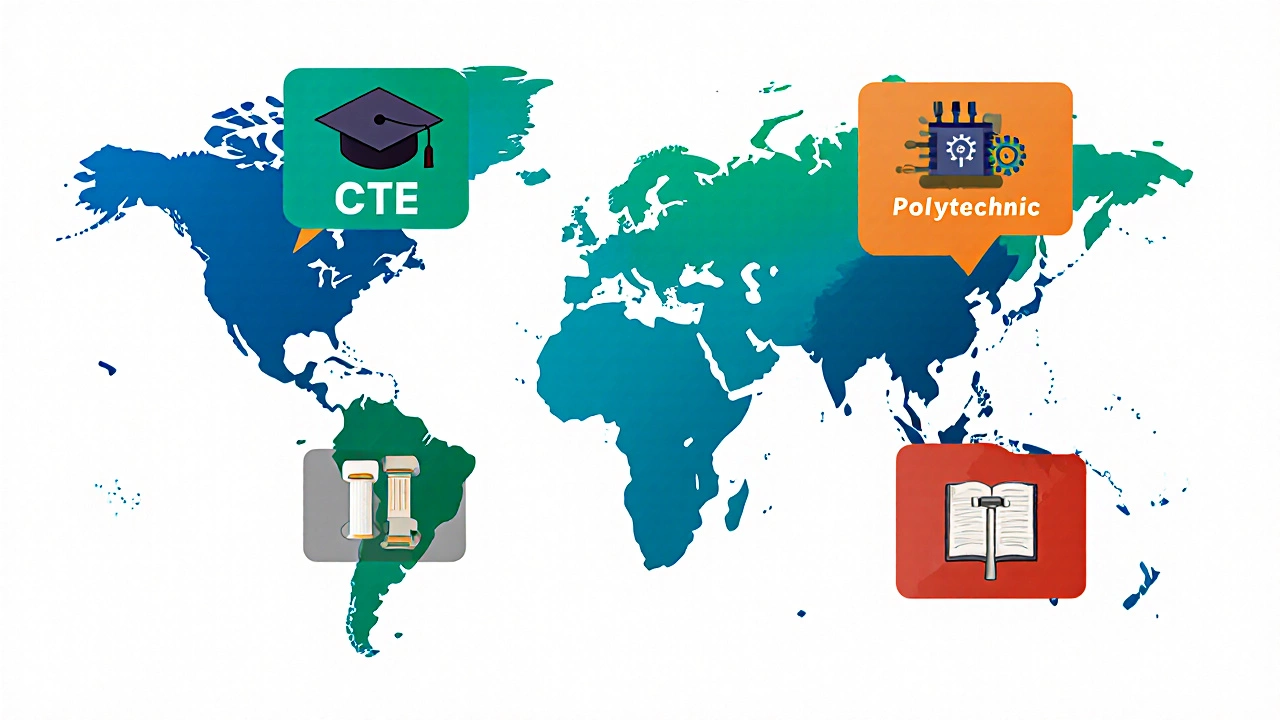Vocational Education Finder
Find the current name for vocational education programs in your region based on your career interest.
Key Takeaways
- Vocational education is now commonly referred to as Career and Technical Education (CTE), TAFE, polytechnic, or skills training, depending on the country.
- The shift in terminology reflects a broader focus on employability, industry partnerships, and lifelong learning.
- In Australia, "TAFE" dominates; in the United States, "CTE" is the preferred label; many European nations use "polytechnic" or "apprenticeship" models.
- All modern names share core attributes: practical curricula, work‑based learning, and alignment with national qualification frameworks.
- Understanding the current terminology helps students, parents, and employers navigate funding, enrollment, and career pathways.
When schools talk about vocational education is a type of learning that equips students with specific job‑ready skills, often through hands‑on training and industry partnerships, the name you hear on brochures can vary wildly. Over the past decade, governments and institutions have rebranded the sector to highlight its role in economic growth and lifelong learning. This article untangles the most common contemporary labels, explains why they matter, and shows how they fit into today’s education landscape.
Why the Name Changed
Historically, vocational education carried a stigma of being a “second‑choice” path after academic schooling. Policymakers wanted to flip that perception, so they introduced names that sound forward‑looking and inclusive. Terms like "Career and Technical Education" emphasize career outcomes, while "Technical and Further Education" (or TAFE) signals a bridge between school and industry.
Key drivers behind the rebranding include:
- Economic imperatives: Rapid tech change means workers need up‑skilling throughout life.
- Policy shifts: Many countries adopted national qualification frameworks that link training directly to job standards.
- Employer demand: Companies prefer graduates who have completed industry‑aligned programs.
Global Labels and What They Mean
Below is a quick map of the most frequently used names across major regions.
- Career and Technical Education (CTE) - United States, Canada, parts of Asia. Focuses on integrating academic and technical coursework.
- Technical and Further Education (TAFE) - Australia and New Zealand. Offers certificates, diplomas, and short courses in trades and services.
- Polytechnic - United Kingdom, France, Germany, Singapore. Provides higher‑level diplomas and bachelor‑type degrees with strong industry links.
- Apprenticeship - Germany (dual system), UK, Ireland. Combines on‑the‑job training with classroom instruction.
- Skills Training - General term used by governments in the Middle East, Africa, and some U.S. states to describe short, competency‑based courses.

Comparison Table: Old vs. New Terminology
| Traditional Term | Current Name | Typical Region | Primary Focus | Common Credential |
|---|---|---|---|---|
| Vocational School | Career and Technical Education (CTE) | USA, Canada | Career pathways that blend academics and technical skills | Certificates, Associate degrees |
| Technical College | Technical and Further Education (TAFE) | Australia, New Zealand | Industry‑driven trades and services | Diplomas, Advanced diplomas |
| Trade School | Apprenticeship | Germany, UK, Ireland | On‑the‑job training plus classroom theory | National qualification, journeyman status |
| Polytechnic Institute | Polytechnic | UK, Singapore, Europe | Applied science and engineering programs | Higher diplomas, Bachelor of Technology |
| Skills Center | Skills Training | Middle East, Africa, US states | Short, competency‑based modules | Micro‑credential, certificate of competence |
Key Features Shared Across All Modern Names
Even though the labels differ, they all share a handful of core attributes. Recognizing these helps you compare programs regardless of the terminology.
- Work‑Based Learning: Internships, apprenticeships, or simulated labs give students real‑world practice.
- Industry Partnerships: Employers co‑design curricula, ensuring relevance.
- Stackable Credentials: Learners can earn a short certificate, then build toward a diploma or higher qualification.
- National Qualification Framework Alignment: In many countries, programs map to frameworks like the National Skills Qualification Framework (NSQF), which standardizes skill levels.
- Lifelong Learning Pathways: Programs are designed for both fresh school leavers and mid‑career up‑skillers.
How to Identify the Right Program for You
When you start searching, use the following checklist. It works whether you’re looking at a "CTE" program in Texas or a "TAFE" course in Auckland.
- Check the qualification level: Certificates (Level 1‑2) for entry‑level skills, diplomas (Level 3‑4) for intermediate, advanced diplomas or bachelor‑type degrees (Level 5‑6) for deeper expertise.
- Verify industry accreditation: Look for endorsements from bodies like the Australian Skills Quality Authority (ASQA) for TAFE, or the U.S. Department of Education’s CTE accreditation.
- Assess work‑placement options: Programs that guarantee a placement or apprenticeship have higher employment outcomes.
- Consider funding sources: Many governments offer vouchers, scholarships, or tax credits tied to specific program names (e.g., the U.S. Workforce Innovation and Opportunity Act funds CTE).
- Match your career goal: If you aim for a trade like electrician, look at apprenticeship pathways; for tech‑focused roles, CTE or polytechnic IT programs may be better.
Real‑World Example: From High School to a Tech Career
Emma, a 17‑year‑old from Wellington, wanted a job in cybersecurity but didn’t want a four‑year university degree. She enrolled in a polytechnic program that offered a Bachelor of Applied Technology with a specialisation in cyber‑defence. The curriculum blended classroom theory, a six‑month industry placement at a local IT firm, and a final project that earned her a national certification through the National Skills Qualification Framework (NSQF). Within a year, Emma secured a junior analyst role, illustrating how modern terminology aligns with clear career routes.
Future Trends: What’s Next for Skills‑Focused Education?
Governments are now drafting policies that merge the best of all these models. Expect to see more "stackable micro‑credentials" that sit alongside traditional diplomas, and greater use of digital badges that employers can verify instantly. Artificial‑intelligence‑driven skills mapping tools will make it easier for learners to see exactly which courses translate into which job outcomes.
Frequently Asked Questions
What does CTE stand for?
CTE means Career and Technical Education, a term used mainly in the United States to describe programs that blend academic subjects with technical skill training.
How is TAFE different from a regular college?
TAFE (Technical and Further Education) focuses on practical, industry‑linked courses ranging from short certificates to advanced diplomas, whereas traditional colleges often emphasise broader academic degrees.
Can I get a university degree from a polytechnic?
Many polytechnics now offer bachelor‑type degrees, especially in engineering, applied science, and information technology. These degrees are usually accredited and recognised by employers.
Is an apprenticeship considered part of vocational education?
Yes. Apprenticeships combine on‑the‑job training with classroom instruction and are a core component of modern vocational pathways, especially in Germany’s dual system and the UK.
What funding options exist for skills training?
Funding varies by country: in Australia, the VET Student Loan supports TAFE; in the U.S., the Workforce Innovation and Opportunity Act provides grants for CTE; many EU nations offer EU‑funded upskilling schemes tied to the NSQF.

